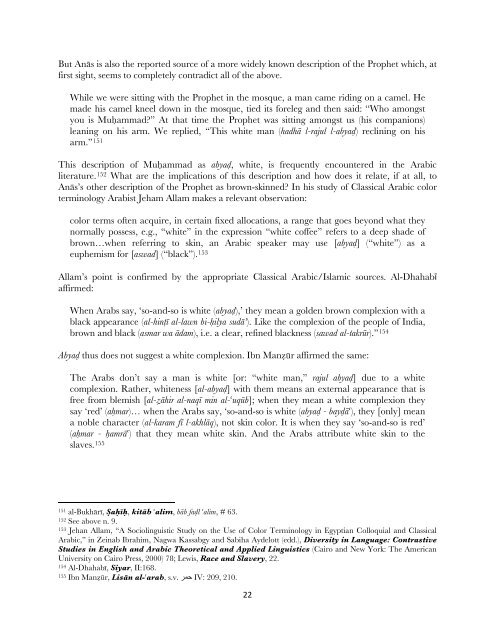“Anyone who says that the Prophet is black should be killed”: The ...
“Anyone who says that the Prophet is black should be killed”: The ...
“Anyone who says that the Prophet is black should be killed”: The ...
Create successful ePaper yourself
Turn your PDF publications into a flip-book with our unique Google optimized e-Paper software.
But An§s <strong>is</strong> also <strong>the</strong> reported source of a more widely known description of <strong>the</strong> <strong>Prophet</strong> which, at<br />
first sight, seems to completely contradict all of <strong>the</strong> above.<br />
While we were sitting with <strong>the</strong> <strong>Prophet</strong> in <strong>the</strong> mosque, a man came riding on a camel. He<br />
made h<strong>is</strong> camel kneel down in <strong>the</strong> mosque, tied its foreleg and <strong>the</strong>n said: “Who amongst<br />
you <strong>is</strong> MuÈammad?” At <strong>that</strong> time <strong>the</strong> <strong>Prophet</strong> was sitting amongst us (h<strong>is</strong> companions)<br />
leaning on h<strong>is</strong> arm. We replied, “Th<strong>is</strong> white man (hadh§ l-rajul l-abya∙) reclining on h<strong>is</strong><br />
arm.” 151<br />
Th<strong>is</strong> description of MuÈammad as abya∙, white, <strong>is</strong> frequently encountered in <strong>the</strong> Arabic<br />
literature. 152 What are <strong>the</strong> implications of th<strong>is</strong> description and how does it relate, if at all, to<br />
An§s’s o<strong>the</strong>r description of <strong>the</strong> <strong>Prophet</strong> as brown-skinned? In h<strong>is</strong> study of Classical Arabic color<br />
terminology Arab<strong>is</strong>t Jeham Allam makes a relevant observation:<br />
color terms often acquire, in certain fixed allocations, a range <strong>that</strong> goes <strong>be</strong>yond what <strong>the</strong>y<br />
normally possess, e.g., “white” in <strong>the</strong> expression “white coffee” refers to a deep shade of<br />
brown…when referring to skin, an Arabic speaker may use [abya∙] (“white”) as a<br />
euphem<strong>is</strong>m for [aswad] (“<strong>black</strong>”). 153<br />
Allam’s point <strong>is</strong> confirmed by <strong>the</strong> appropriate Classical Arabic/Islamic sources. Al-Dhahabī<br />
affirmed:<br />
When Arabs say, ‘so-and-so <strong>is</strong> white (abya∙),’ <strong>the</strong>y mean a golden brown complexion with a<br />
<strong>black</strong> appearance (al-hinãÊ al-lawn bi-Èilya sud§"). Like <strong>the</strong> complexion of <strong>the</strong> people of India,<br />
brown and <strong>black</strong> (asmar wa §dam), i.e. a clear, refined <strong>black</strong>ness (sawad al-takrår).” 154<br />
Abya∙ thus does not suggest a white complexion. Ibn Maníår affirmed <strong>the</strong> same:<br />
<strong>The</strong> Arabs don’t say a man <strong>is</strong> white [or: “white man,” rajul abya∙] due to a white<br />
complexion. Ra<strong>the</strong>r, whiteness [al-abya∙] with <strong>the</strong>m means an external appearance <strong>that</strong> <strong>is</strong><br />
free from blem<strong>is</strong>h [al-í§hir al-naqÊ min al-#uqåb]; when <strong>the</strong>y mean a white complexion <strong>the</strong>y<br />
say ‘red’ (aÈmar)… when <strong>the</strong> Arabs say, ‘so-and-so <strong>is</strong> white (abya∙ - bay∙§#), <strong>the</strong>y [only] mean<br />
a noble character (al-karam fÊ l-akhl§q), not skin color. It <strong>is</strong> when <strong>the</strong>y say ‘so-and-so <strong>is</strong> red’<br />
(aÈmar - Èamr§#) <strong>that</strong> <strong>the</strong>y mean white skin. And <strong>the</strong> Arabs attribute white skin to <strong>the</strong><br />
slaves. 155<br />
151 al-Bukh§rÊ, ‘aÈÊÈ, kit§b #alim, b§b fa∙l #alim, # 63.<br />
152 See above n. 9.<br />
153 Jehan Allam, “A Sociolingu<strong>is</strong>tic Study on <strong>the</strong> Use of Color Terminology in Egyptian Colloquial and Classical<br />
Arabic,” in Zeinab Ibrahim, Nagwa Kassabgy and Sabiha Aydelott (edd.), Diversity in Language: Contrastive<br />
Studies in Engl<strong>is</strong>h and Arabic <strong>The</strong>oretical and Applied Lingu<strong>is</strong>tics (Cairo and New York: <strong>The</strong> American<br />
University on Cairo Press, 2000) 78; Lew<strong>is</strong>, Race and Slavery, 22.<br />
154 Al-DhahabÊ, Siyar, II:168.<br />
155 Ibn Maníår, L<strong>is</strong>§n al-#arab, s.v. ﺮﻤﺣ IV: 209, 210.<br />
22
















